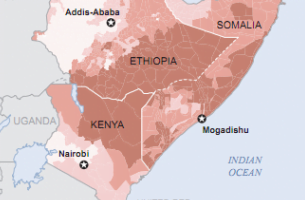The worst drought in 60 years is causing the first famine in over 20 years in East Africa. That, in turn is causing a massive population flow. Families are scrambling to leave famine stricken areas, and are arriving in over-crowded refugee camps in Kenya and Ethiopia.
Some 3,000 people are arriving daily according to the UN Refugee Agency (UNHCR).
“They are walking for days and days and days to reach the camps,” says Charity Tooze of UNHCR. “Children are dying when they get to the camps. They have traveled too far.”
To make matters worse, the security situation in southern Somalia is preventing aid agencies from reaching people before they arrive in the camps. (Nearly every UN agency has been a target of terrorism or banditry in Somalia. Some of these areas are simply no-go places for aid agencies.)
International humanitarian groups like the UN Refugee Agency, UNICEF and the World Food Programme have been warning about this impending disaster in the Horn of Africa for some time. So far, though, donors have not stepped up to the demand. Out of $1.87 billion in humanitarian requirements for Djibouti, Ethiopia, Kenya and Somalia, only some 45 percent have been funded at mid-year, leaving a gap of about $1 billion.
On July 25, the Food and Agriculture Organization is hosting a major pledging conference, which was called for by France (which currently heads the G-20.) It is a ministerial level meeting, meaning foreign ministers — and possible Secretary of State Clinton — will attend.
This could not come at a more desperate time. “We need the international community to provide more funding for the situation,” says UNHCR’s Tooze. “People are leaving their crops to go fallow. We see the situation with the famine as something that can get worse.”

